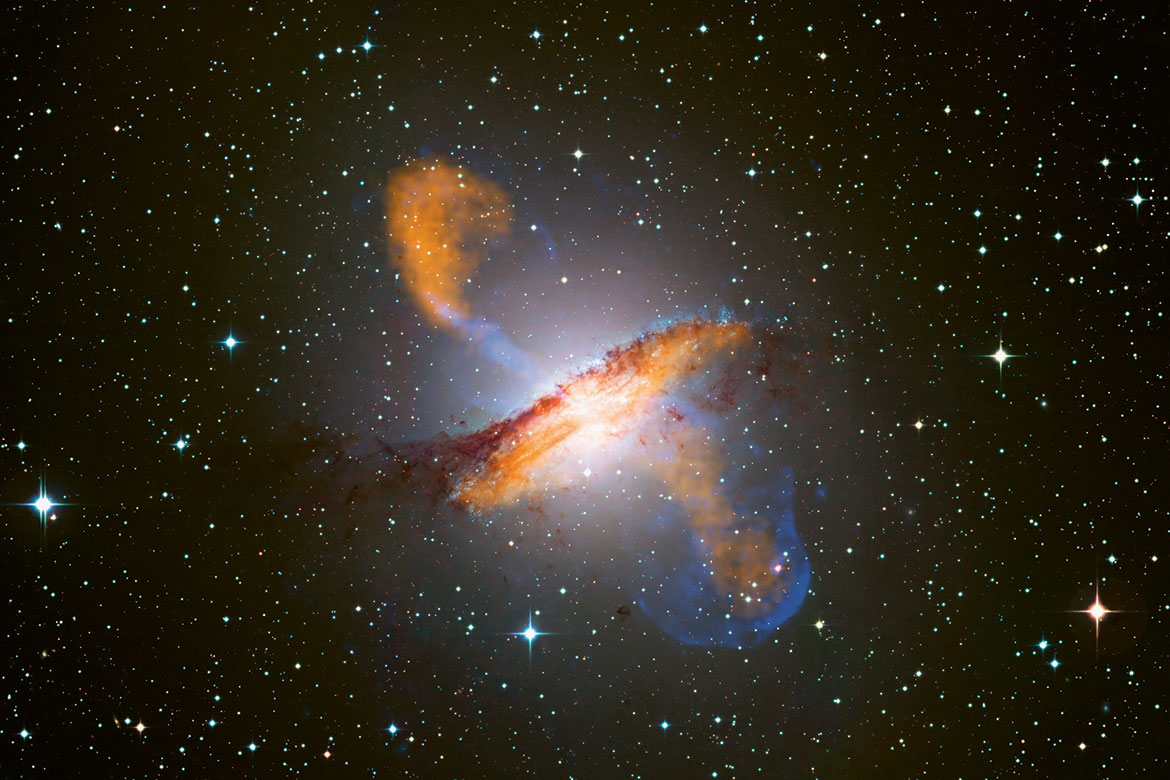Does dark matter really exist?
The existence of dark matter has been posited for over 80 years, but scientists still haven’t found any proof of its actual existence. So some researchers are trying a different approach. In order to explain the nature of the galaxy, they’re trying to redefine gravity.

The galaxy Centaurus A, a neighbour of the Milky Way. The distribution of dwarf galaxies belonging to the same constellation contradicts the standard cosmological model. | Image: ESO/WFI (Optical); MPIfR/ESO/APEX/A.Weiss et al. (Submillimetre); NASA/CXC/CfA/R.Kraft et al. (X-ray)
When the Swiss astrophysicist Fritz Zwicky pointed his telescope at the Coma Cluster with its more than one thousand galaxies, he discovered something strange. Some of these galaxies were moving around the centre of the cluster so quickly that they really ought to have been catapulted out of it. So Zwicky postulated the existence of something holding the galaxies together: a dark, invisible mass. He called it dark matter. That was back in 1933.
Today, most physicists are convinced of the existence of dark matter, which they claim makes up more than 80 percent of all matter in the Universe. Even laypeople understand the principle behind it. We need dark matter in order to grasp how galaxies work.
Martin Kunz, an astrophysicist at the University of Geneva, explains that the structures of the Universe just could not function on a huge cosmological scale without dark matter. The current best cosmological model also depends on it: the so-called Lambda-CDM model, also known as the Standard Model. Using just a few parameters, it describes the development of the Universe since the Big Bang. It can explain important observations, such as the Universe’s accelerating expansion rate, the cosmic microwave background, or the honeycomb-like distribution of galaxies with enhanced clusters of galaxies linked by thin, thread-like structures with vast empty spaces between them – the so-called voids.
And yet the existence of dark matter has never actually been confirmed. For 30 years, physicists have been trying to find particles of this invisible matter. In technical jargon, these particles are called WIMPs, ‘Weakly Interacting Massive Particles’, because they almost never interact with known matter. Researchers hunt for them in space using instruments on the International Space Station (ISS), they hunt for them deep in the Earth in former mines and under mountains, shielded from cosmic disturbances, and they also hunt for them in ingenious experiments at the European Nuclear Research Centre (CERN) near Geneva. But time and again, they come up with nothing. Physicists have not yet even discovered the small, regularly distributed black holes that supposedly arose shortly after the Big Bang, and which the latest theories claim also account for the existence of dark matter.
Another approach: modified gravity
The fact that even the most sophisticated experiments can find no direct trace of dark matter is at the very least “strange”, as Kunz himself admits. That’s why some scientists, including certain Swiss researchers, are now taking a different, still rather unpopular approach. They are modifying gravitational theory so that it fits the data provided by the telescopes. Current gravitational theory is unable to describe the movement of visible matter from a certain acceleration point onwards. One possibility would be to add an “invisible” mass to the equation. Then you end up with dark matter.
Another possibility is to adapt the laws of gravity themselves. In 1983, researchers proposed the MOND Theory for the very first time, which has since been the subject of much controversial debate. Its name is derived from ‘modified Newtonian dynamics’, and it tries to explain away dark matter by creating a subtler definition of gravity. At higher degrees of acceleration, such as are found at the centre of galaxies, classical Newtonian dynamics still apply, with the rotational speed proportional to the squared distance. But at slower accelerations at the edges of the galaxies, it remains constant and is no longer dependent on the distance. In these cases, gravity would no longer follow Newton’s laws.
“We can in fact observe this in every galaxy that has ever been measured”, says the Swiss astrophysicist Oliver Müller, who is currently doing research at the University of Strasbourg. “We know of similar things in classical mechanics. But from a certain point onwards, it doesn’t work any more. That’s why we need quantum mechanics”.
Strange dwarf galaxies
Last year, when he was still working on his doctorate at the University of Basel, Müller was also busy evaluating data from telescopes. Just like Fritz Zwicky, he too came across strange phenomena. He found dwarf galaxies in the constellation of Centaurus moving on a plane, all in the same direction around the central galaxy Centaurus A. They weren’t distributed randomly either, as is predicted by the large cosmological simulations using the Standard Model.
Müller’s subsequent article, published last year in the specialist journal ‘Science’, caused quite a stir. The distribution of galaxies such as those of Centaurus is still allowed in the Lambda-CDM model, but it predicts that only one out of a thousand galaxies could have such a structure. The problem is that the same phenomenon can be seen in our own local group of galaxies, both in the Milky Way and in the Andromeda Galaxy. “If the three closest galaxies have to be regarded as outliers, then something can’t be right about the basic assumptions found in the Standard Model”, says Müller.
However, he does not simply assume that the whole Standard Model is wrong, because it offers too many observations of the Universe that are correct. Müller is simply pointing out certain discrepancies between his observations and the simulations of dark matter. “Perhaps we are missing something additional in the simulations”, he says. “It’s also possible that our galactic neighbours are just very special”. This is because the Milky Way, the Andromeda Galaxy and Centaurus A all lie on the edge of a huge void, and have the Virgo cluster of galaxies in direct proximity. Their mass distribution could thus lead to unusual phenomena.
The future will bring answers
The question as to whether dark matter might be ‘replaced’ by modified gravity can’t be answered yet. Only further measurements might help. Observations of very early galaxies could provide answers, because the two approaches predict different things here. According to the MOND theory, galaxy clusters would form quicker on account of their additional gravity, whereas in the Lambda-CDM model, this process would take longer. “That would be a test to decide between MOND and Lambda-CDM”, says Müller.
At present, preparations are underway for various large-scale experiments that might demonstrate who is right. There is NASA’s new James Webb Space Telescope, which is due to start operating in 2021, then there is the ESA satellite Euclid and the ‘Square Kilometer Array’ international radio telescope, which will be 50 times more sensitive than today’s telescopes. Using these means, researchers might soon be able to get more details about the precise structures of the Universe.




